
The geothermal areas of Yellowstone include several geyser basins in Yellowstone National Park as well as other geothermal features such as hot springs, mud pots, and fumaroles. The number of thermal features in Yellowstone is estimated at 10,000. A study that was completed in 2011 found that a total of 1,283 geysers have erupted in Yellowstone, 465 of which are active during an average year. These are distributed among nine geyser basins, with a few geysers found in smaller thermal areas throughout the Park. The number of geysers in each geyser basin are as follows: Upper Geyser Basin (410), Midway Geyser Basin (59), Lower Geyser Basin (283), Norris Geyser Basin (193), West Thumb Geyser Basin (84), Gibbon Geyser Basin (24), Lone Star Geyser Basin (21), Shoshone Geyser Basin (107), Heart Lake Geyser Basin (69), other areas (33). Although famous large geysers like Old Faithful are part of the total, most of Yellowstone's geysers are small, erupting to only a foot or two. The hydrothermal system that supplies the geysers with hot water sits within an ancient active caldera. Many of the thermal features in Yellowstone build up sinter, geyserite, or travertine deposits around and within them.
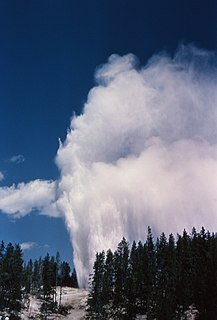
Steamboat Geyser, in Yellowstone National Park's Norris Geyser Basin, is the world's tallest currently-active geyser. Steamboat Geyser has two vents, a northern and a southern, approximately 20 feet (6.1 m) apart.

Grand Geyser is a fountain geyser in the Upper Geyser Basin of Yellowstone National Park in the United States. It is the tallest predictable geyser known. It was named by Dr. F.V. Hayden in 1871.

The Fountain Paint Pot is a mud pot located in Lower Geyser Basin in Yellowstone National Park.
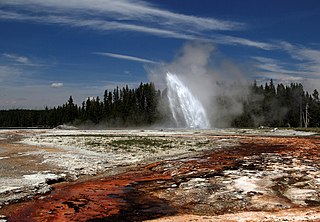
Daisy Geyser is a geyser in the Upper Geyser Basin of Yellowstone National Park in the United States.
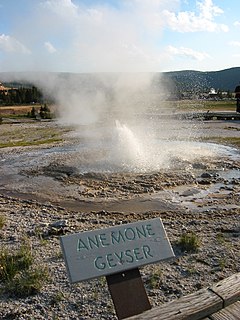
Anemone Geyser is a geyser in the Upper Geyser Basin of Yellowstone National Park in the United States. Anemone is actually two closely related geysers. The larger of the two is known as Big or North Anemone while the smaller is known as Little or South Anemone. The two geysers were named after the anemone flower by the Hague Party in 1904. Both vents have a pale yellow color and shape similar to the flower.

A-0 Geyser is a geyser in the Lower Geyser Basin of Yellowstone National Park in the United States.

Botryoidal Spring is a fountain-type geyser in the Lower Geyser Basin of Yellowstone National Park in the United States.

Artemisia Geyser is a geyser in the Upper Geyser Basin of Yellowstone National Park in the United States.
Box Spring is a geyser in the Lower Geyser Basin of Yellowstone National Park in the United States.
Dilemma Geyser is a geyser in the Lower Geyser Basin of Yellowstone National Park in the United States. It is part of the Pink Cone complex. Other geysers in this group are Bead Geyser, Box Spring, Labial Geyser, Labial's Satellite Geyser, Narcissus Geyser, Pink Geyser, and Pink Cone Geyser.
Pink Geyser is a fountain-type geyser in the Lower Geyser Basin of Yellowstone National Park in the United States.
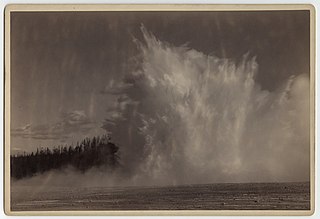
Excelsior Geyser Crater, formerly known as Excelsior Geyser, is a dormant fountain-type geyser in the Midway Geyser Basin of Yellowstone National Park in the United States. Excelsior was named by the Hayden Geological Survey of 1871.

Beehive Geyser is a geyser in the Upper Geyser Basin of Yellowstone National Park in the United States. The 4-foot (1.2 m) tall cone resembles a beehive. Beehive's Indicator is a small, jagged cone-type geyser located about 10 feet (3.0 m) from Beehive.

Clepsydra Geyser is a geyser in the Lower Geyser Basin of Yellowstone National Park in the United States.
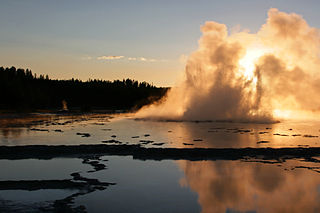
The Great Fountain Geyser is a fountain-type geyser located in the Firehole Lake area of Lower Geyser Basin of Yellowstone National Park, Wyoming. It is the only Lower Geyser Basin feature that the park makes predictions for.
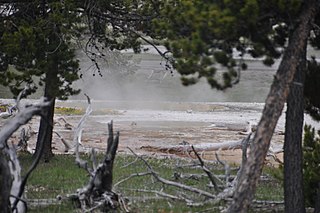
Baby Daisy Geyser is a geyser in the Upper Geyser Basin of Yellowstone National Park in the United States. It is part of the Old Road group of geysers.

Jet Geyser is a geyser in the Lower Geyser Basin of Yellowstone National Park in the United States. Jet Geyser is in the Fountain Group that includes Fountain Geyser, Morning Geyser, Red Spouter and Silex Spring.

White Dome Geyser is a geyser located in the Lower Geyser Basin in Yellowstone National Park in the United States.






















